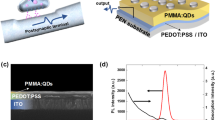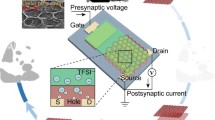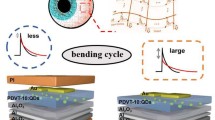Abstract
Neuromorphic materials are promising for fabricating artificial synapses for flexible electronics, but they are usually expensive and lack a good combination of electronic and mechanical properties. In this paper, low-cost flexible carbon nanotube/polydimethylsiloxane (CNT/PDMS) nanocomposites were prepared by solution processing. Their neuromorphic properties were studied as a function of PDMS macromolecular network structure. Specifically, the structural defects of the polymer network originating from intermolecular crosslinking reactions were tuned to tailor the electron transfer between carbon nanotubes, resulting in a recorded low switching power consumption (1.40 × 10–10 W) and a high working bending radius of curvature (5 mm) compared to other organic, flexible neuromorphic materials. As-fabricated CNT/PDMS composites demonstrate robust performance for 104 operating cycles under mechanical deformation. Emulation of synaptic functions was also presented, showing long-term potentiation (LTP) and long-term depression (LTD) characteristics. These results lay a foundation for networked polymer-based multifunctional nanocomposites for flexible neuromorphic electronic devices.







Similar content being viewed by others
References
Narayana KJ, Gupta Burela R (2018) A review of recent research on multifunctional composite materials and structures with their applications. Mater Today Proc 5:5580–5590. https://doi.org/10.1016/j.matpr.2017.12.149
Ali A, Andriyana A (2020) Properties of multifunctional composite materials based on nanomaterials: a review. RSC Adv 10:16390–16403. https://doi.org/10.1039/C9RA10594H
Sun F, Lu Q, Feng S, Zhang T (2021) Flexible artificial sensory systems based on neuromorphic devices. ACS Nano 15:3875–3899. https://doi.org/10.1021/acsnano.0c10049
Lee S, Kim S, Yoo H (2021) Contribution of polymers to electronic memory devices and applications. Polymers (Basel). https://doi.org/10.3390/polym13213774
Ghoneim MT, Hussain MM (2015) Review on physically flexible nonvolatile memory for internet of everything electronics. Electronics (Basel) 4:424–479. https://doi.org/10.3390/electronics4030424
Wang T-Y, Meng J-L, Rao M-Y, He Z-Y, Chen L, Zhu H, Sun Q-Q, Ding S-J, Bao W-Z, Zhou P, Zhang DW (2020) Three-dimensional nanoscale flexible memristor networks with ultralow power for information transmission and processing application. Nano Lett 20:4111–4120. https://doi.org/10.1021/acs.nanolett.9b05271
Wang T-Y, Meng J-L, Li Q-X, Chen L, Zhu H, Sun Q-Q, Ding S-J, Zhang DW (2021) Forming-free flexible memristor with multilevel storage for neuromorphic computing by full PVD technique. J Mater Sci Technol 60:21–26. https://doi.org/10.1016/j.jmst.2020.04.059
Zhu Y, Liang J, Mathayan V, Nyberg T, Primetzhofer D, Shi X, Zhang Z (2022) High performance full-Inorganic flexible memristor with combined resistance-switching. ACS Appl Mater Interfaces 14:21173–21180. https://doi.org/10.1021/acsami.2c02264
Zhang H, Liu R, Zhao H, Sun Z, Liu Z, He L, Li Y (2021) Research progress of biomimetic memristor flexible synapse. Coatings 12:21. https://doi.org/10.3390/coatings12010021
Fu T, Liu X, Gao H, Ward JE, Liu X, Yin B, Wang Z, Zhuo Y, Walker DJF, Joshua Yang J, Chen J, Lovley DR, Yao J (2020) Bioinspired bio-voltage memristors. Nat Commun 11:1–10. https://doi.org/10.1038/s41467-020-15759-y
Kim M-K, Lee J-S (2018) Ultralow power consumption flexible biomemristors. ACS Appl Mater Interfaces 10:10280–10286. https://doi.org/10.1021/acsami.8b01781
Ge J, Li D, Huang C, Zhao X, Qin J, Liu H, Ye W, Xu W, Liu Z, Pan S (2020) Memristive synapses with high reproducibility for flexible neuromorphic networks based on biological nanocomposites. Nanoscale 12:720–730. https://doi.org/10.1039/C9NR08001E
Austin MJ, Rosales AM (2019) Tunable biomaterials from synthetic, sequence-controlled polymers. Biomater Sci 7:490–505. https://doi.org/10.1039/C8BM01215F
Tan Y, Adhikari RY, Malvankar NS, Ward JE, Woodard TL, Nevin KP, Lovley DR (2017) Expressing the Geobacter metallireducens PilA in Geobacter sulfurreducens yields pili with exceptional conductivity. mBio 8. https://doi.org/10.1128/mBio.02203-16
Liu X, Gao H, Ward JE, Liu X, Yin B, Fu T, Chen J, Lovley DR, Yao J (2020) Power generation from ambient humidity using protein nanowires. Nature 578:550–554. https://doi.org/10.1038/s41586-020-2010-9
Kausar A (2020) Polydimethylsiloxane-based nanocomposite: present research scenario and emergent future trends. Polym-Plast Technol Mat 59:1148–1166. https://doi.org/10.1080/25740881.2020.1719149
Wang F, Tay TE, Sun Y, Liang W, Yang B (2019) Low-voltage and -surface energy SWCNT/poly(dimethylsiloxane) (PDMS) nanocomposite film: surface wettability for passive anti-icing and surface-skin heating for active deicing. Compos Sci Technol 184:107872. https://doi.org/10.1016/j.compscitech.2019.107872
Li Z, Nambiar S, Zheng W, Yeow JTW (2013) PDMS/single-walled carbon nanotube composite for proton radiation shielding in space applications. Mater Lett 108:79–83. https://doi.org/10.1016/j.matlet.2013.06.030
Flory PJ (1979) Molecular theory of rubber elasticity Polymer (Guildf) 20:1317–1320. https://doi.org/10.1016/0032-3861(79)90268-4
Flory PJ, Rehner J (1943) Statistical mechanics of cross-linked polymer networks I. Rubberlike elasticity J Chem Phys 11:512–520. https://doi.org/10.1063/1.1723791
Bae S, Galant O, Diesendruck CE, Silberstein MN (2018) The effect of intrachain cross-linking on the thermomechanical behavior of bulk polymers assembled solely from single chain polymer nanoparticles. Macromolecules 51:7160–7168. https://doi.org/10.1021/acs.macromol.8b01027
Kim JG, Jeon J, Sivakumar R, Lee J, Kim YH, Cho M, Youk JH, Wie JJ (2021) Light-fueled climbing of monolithic torsional soft robots via molecular engineering. Adv Intell Syst 4(3):2100148. https://doi.org/10.1002/aisy.202100148
Deng F, Zheng QS (2008) An analytical model of effective electrical conductivity of carbon nanotube composites. Appl Phys Lett. https://doi.org/10.1063/1.2857468
Goswami S, Goswami S, Venkatesan T (2020) An organic approach to low energy memory and brain inspired electronics. Appl Phys Rev 7:21303. https://doi.org/10.1063/1.5124155
Mutiso RM, Sherrott MC, Li J, Winey KI (2012) Simulations and generalized model of the effect of filler size dispersity on electrical percolation in rod networks. Phys Rev B Condens Matter Mater Phys. https://doi.org/10.1103/PhysRevB.86.214306
Zhang P, Ang YS, Garner AL, Valfells Á, Luginsland JW, Ang LK (2021) Space-charge limited current in nanodiodes: ballistic, collisional, and dynamical effects. J Appl Phys. https://doi.org/10.1063/5.0042355
Parodi F (1989) Physics and chemistry of microwave processing. In: Allen G, Bevington JCBT-CPS and S (eds) Comprehensive polymer science and supplements. Elsevier, Amsterdam, pp 669–728
Mark P, Helfrich W (1962) Space-charge-limited currents in organic crystals. J Appl Phys 33:205–215. https://doi.org/10.1063/1.1728487
Wang T, Meng J, Chen L, Zhu H, Sun Q, Ding S, Bao W, Zhang DW (2021) Flexible 3D memristor array for binary storage and multi-states neuromorphic computing applications. InfoMat 3:212–221. https://doi.org/10.1002/inf2.12158
Lee SH, Park HL, Kim MH, Kang S, Lee SD (2019) Interfacial triggering of conductive filament growth in organic flexible memristor for high reliability and uniformity. ACS Appl Mater Interfaces 11:30108–30115. https://doi.org/10.1021/acsami.9b10491
Ji X, Song L, Zhong S, Jiang Y, Lim KG, Wang C, Zhao R (2018) Biodegradable and flexible resistive memory for transient electronics. J Phys Chem C 122:16909–16915. https://doi.org/10.1021/acs.jpcc.8b03075
Xu J, Zhao X, Wang Z, Xu H, Hu J, Ma J, Liu Y (2019) Biodegradable natural pectin-based flexible multilevel resistive switching memory for transient electronics. Small 15:1803970. https://doi.org/10.1002/smll.201803970
Lee S-H, Park H-L, Keum C-M, Lee I-H, Kim M-H, Lee S-D (2019) Organic flexible memristor with reduced operating voltage and high stability by interfacial control of conductive filament Growth. Phys Status Solidi – Rapid Res Lett 13:1900044. https://doi.org/10.1002/pssr.201900044
Hosseini NR, Lee J-S (2015) Biocompatible and flexible chitosan-based resistive switching memory with magnesium electrodes. Adv Funct Mater 25:5586–5592. https://doi.org/10.1002/adfm.201502592
Choi MK, Kim WK, Sung S, Wu C, Kim HW, Kim TW (2018) Flexible memristive devices based on polyimide:mica nanosheet nanocomposites with an embedded PEDOT:PSS layer. Sci Rep 8:1–8. https://doi.org/10.1038/s41598-018-30771-5
Qian M, Pan Y, Liu F, Wang M, Shen H, He D, Wang B, Shi Y, Miao F, Wang X (2014) Tunable, ultralow-power switching in memristive devices enabled by a heterogeneous graphene-oxide interface. Adv Mater 26:3275–3281. https://doi.org/10.1002/adma.201306028
Zhang C, Tai YT, Shang J, Liu G, Wang KL, Hsu C, Yi X, Yang X, Xue W, Tan H, Guo S, Pan L, Li RW (2016) Synaptic plasticity and learning behaviours in flexible artificial synapse based on polymer/viologen system. J Mater Chem C Mater 4:3217–3223. https://doi.org/10.1039/c6tc00496b
Raeis-Hosseini N, Park Y, Lee JS (2018) Flexible artificial synaptic devices based on collagen from fish protein with spike-timing-dependent plasticity. Adv Funct Mater 28:1–9. https://doi.org/10.1002/adfm.201800553
Wu C, Kim TW, Guo T, Li F, Lee DU, Yang JJ (2017) Mimicking classical conditioning based on a single flexible memristor. Adv Mater. https://doi.org/10.1002/adma.201602890
Le VQ, Do TH, Retamal JRD, Shao PW, Lai YH, Wu WW, He JH, Chueh YL, Chu YH (2019) Van der Waals heteroepitaxial AZO/NiO/AZO/muscovite (ANA/muscovite) transparent flexible memristor. Nano Energy 56:322–329. https://doi.org/10.1016/j.nanoen.2018.10.042
Qian K, Tay RY, Lin MF, Chen J, Li H, Lin J, Wang J, Cai G, Nguyen VC, Teo EHT, Chen T, Lee PS (2017) Direct observation of indium conductive filaments in transparent, flexible, and transferable resistive switching memory. ACS Nano 11:1712–1718. https://doi.org/10.1021/acsnano.6b07577
Yeom SW, You B, Cho K, Jung HY, Park J, Shin C, Ju BK, Kim JW (2017) Silver nanowire/colorless-polyimide composite electrode: application in flexible and transparent resistive switching memory. Sci Rep 7:1–9. https://doi.org/10.1038/s41598-017-03746-1
Kim M, Choi KC (2017) Transparent and flexible resistive random access memory based on Al2O3 film with multilayer electrodes. IEEE Trans Electron Devices 64:3508–3510. https://doi.org/10.1109/TED.2017.2716831
Won Seo J, Park JW, Lim KS, Kang SJ, Hong YH, Yang JH, Fang L, Sung GY, Kim HK (2009) Transparent flexible resistive random access memory fabricated at room temperature. Appl Phys Lett 95:1–4. https://doi.org/10.1063/1.3242381
Kim S, Son JH, Lee SH, You BK, Il PK, Lee HK, Byun M, Lee KJ (2014) Flexible crossbar-structured resistive memory arrays on plastic substrates via inorganic-based laser lift-off. Adv Mater 26:7480–7487. https://doi.org/10.1002/adma.201402472
Liu Y, Wu L, Liu Q, Liu L, Ke S, Peng Z, Shi T, Yuan X, Huang H, Li J, Ye C, Chu PK, Wang J, Yu XF (2021) Topochemical synthesis of copper phosphide nanoribbons for flexible optoelectronic memristors. Adv Funct Mater 2110900:1–8. https://doi.org/10.1002/adfm.202110900
Funding
The authors appreciate the funding support from the National Science Foundation and Texas A&M President’s Excellent Fund.
Author information
Authors and Affiliations
Contributions
S.W. conceived the research. S. W., R. L., and J. K. designed the experiments. R. L., J. K., P. D., A. H., W.L., and J. M. prepared samples and measured the properties. R. L., J. K., J. Q., C. M., M. Z., and S. W. analyzed the data and wrote the manuscript with comments and inputs from all authors.
Corresponding author
Ethics declarations
Conflict of interest
The authors declare that they have no conflict of interest.
Additional information
Publisher's Note
Springer Nature remains neutral with regard to jurisdictional claims in published maps and institutional affiliations.
Supplementary Information
Below is the link to the electronic supplementary material.
Rights and permissions
Springer Nature or its licensor (e.g. a society or other partner) holds exclusive rights to this article under a publishing agreement with the author(s) or other rightsholder(s); author self-archiving of the accepted manuscript version of this article is solely governed by the terms of such publishing agreement and applicable law.
About this article
Cite this article
Liu, R., Kim, J.G., Dhakal, P. et al. Neuromorphic properties of flexible carbon nanotube/polydimethylsiloxane nanocomposites. Adv Compos Hybrid Mater 6, 14 (2023). https://doi.org/10.1007/s42114-022-00599-9
Received:
Revised:
Accepted:
Published:
DOI: https://doi.org/10.1007/s42114-022-00599-9




